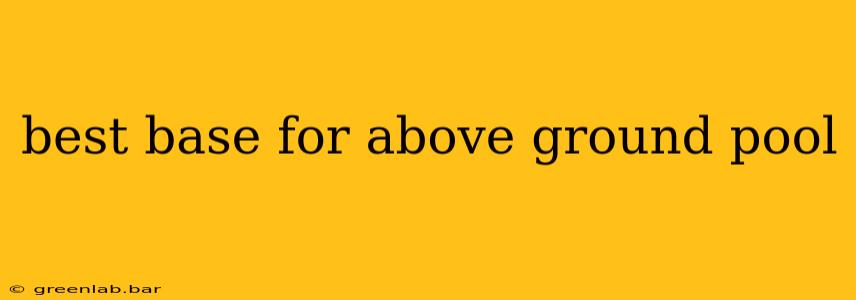Choosing the right base for your above-ground pool is crucial for its longevity, stability, and overall enjoyment. A poorly prepared base can lead to uneven settling, structural damage, and even leaks. This comprehensive guide will explore the best options, helping you make an informed decision before you dive in.
Why a Solid Base is Paramount
Before diving into the best materials, let's understand why a solid base is so important. Your above-ground pool, even a relatively lightweight model, exerts considerable pressure on the ground, particularly when filled with water. An uneven or unstable base will distribute this weight inconsistently, resulting in:
- Uneven Settling: This leads to warping of the pool walls and potential damage to the liner.
- Pooling Water: Low spots can create puddles, leading to stagnant water and potential mosquito breeding grounds.
- Structural Weakness: An inadequate base can compromise the pool's structural integrity, potentially leading to collapse.
- Leaks: Sharp objects or uneven surfaces can puncture the pool liner.
Top Base Materials for Above Ground Pools: A Detailed Comparison
Several options exist for creating a solid and stable base. The best choice depends on your budget, the condition of your existing ground, and your DIY skills.
1. Compacted Gravel Base: A Popular and Budget-Friendly Choice
A compacted gravel base is a classic and widely recommended option. It's relatively inexpensive and relatively easy to install. Here's what you need to know:
- Process: Begin by leveling the ground. Then, lay down a layer of crushed stone (approximately 2-4 inches thick), ensuring even distribution. Compact it thoroughly using a plate compactor (rental available at most equipment stores) for optimal stability. A final layer of pea gravel can add further stability and prevent shifting.
- Pros: Affordable, excellent drainage, relatively easy to install.
- Cons: Requires significant labor for compacting, can shift slightly over time (especially in areas with fluctuating soil conditions).
2. Concrete Slab: The Most Durable and Stable Solution
A concrete slab provides the most stable and durable base for your above-ground pool. It's the best option for long-term stability and peace of mind.
- Process: This requires professional installation unless you're an experienced concrete worker. The area needs to be carefully leveled and a form created to pour the concrete slab. Rebar reinforcement is often used for added strength. Allow ample curing time before installing the pool.
- Pros: Extremely stable, long-lasting, minimizes settling.
- Cons: Expensive, requires professional installation in most cases, more complex to install.
3. Patio Pavers: A Stylish and Functional Alternative
Patio pavers offer a blend of aesthetics and functionality. They provide a stable base while adding a decorative touch to your backyard.
- Process: Requires a well-leveled base layer (often compacted gravel). Pavers are then laid on top, creating a stable and relatively level surface. Use polymeric sand to fill the gaps between pavers, preventing shifting.
- Pros: Stylish, durable, relatively easy to install (compared to concrete).
- Cons: More expensive than gravel, requires careful planning and installation to prevent shifting.
4. Wood Base (Less Recommended): Considerations and Cautions
While some sources suggest using wood, it’s generally not recommended due to its susceptibility to rot and insect infestation. If considering wood, opt for pressure-treated lumber and ensure proper waterproofing and ventilation to mitigate the risks.
Choosing the Best Base for Your Pool
The ideal base depends on several factors:
- Budget: Gravel is the most budget-friendly; concrete is the most expensive.
- Soil Conditions: Poorly draining soil might necessitate additional drainage measures regardless of the base material.
- DIY Skills: Gravel is relatively easy to install yourself; concrete usually requires professional help.
- Aesthetics: Pavers add a decorative element to your backyard.
Careful planning and preparation are essential for a successful above-ground pool installation. Investing time and effort in creating a solid base will ensure years of safe and enjoyable use. Remember to consult local building codes and regulations before beginning your project.

